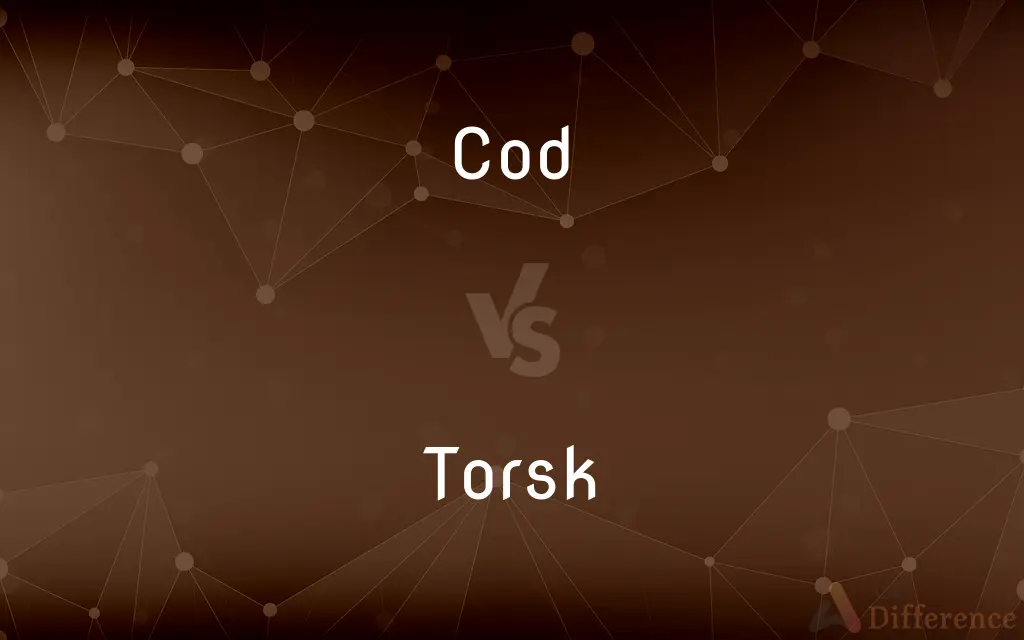Cod vs. Torsk — What's the Difference?
Edited by Tayyaba Rehman — By Maham Liaqat — Updated on March 24, 2024
Cod refers to fish from the genus Gadus, known for its mild flavor, while torsk is a term for Atlantic cod caught in colder Scandinavian waters, often considered a delicacy.

Difference Between Cod and Torsk
Table of Contents
ADVERTISEMENT
Key Differences
Cod, particularly Atlantic cod (Gadus morhua) and Pacific cod (Gadus macrocephalus), is a staple seafood in many cultures, prized for its light, flaky texture and versatility in cooking. Torsk, on the other hand, specifically refers to Atlantic cod that is caught in the colder, northern waters of Scandinavia, and is often regarded as a delicacy due to its slightly different texture and flavor profile, attributed to the colder habitat.
Both cod and torsk are the same species, but the distinction comes from the geographical location where the fish are caught and, consequently, slight variations in taste and texture. The colder water in the Scandinavian region is believed to contribute to a firmer texture and a more pronounced flavor in torsk compared to cod caught in warmer or different waters.
Cod is widely used in a variety of dishes, from fried fish and chips in the UK to the Portuguese bacalhau. Torsk is typically prepared with more traditional Scandinavian cooking methods, which may include boiling, poaching, or baking, often accompanied by simple, classic sides like boiled potatoes and melted butter.
The nutritional content of cod and torsk is similar, providing a good source of lean protein, omega-3 fatty acids, vitamins, and minerals. However, culinary preferences might lead to different preparation and serving methods, potentially affecting the nutritional profile based on cooking techniques and added ingredients.
In terms of availability, cod is commonly found in supermarkets and fish markets around the world, available fresh, frozen, or processed. Torsk, while also available, might be marketed specifically under its Scandinavian name in regions outside Scandinavia, often at a premium due to its perceived quality and delicacy status.
ADVERTISEMENT
Comparison Chart
Definition
A popular seafood fish from the genus Gadus, known for its mild flavor and flaky texture.
A term for Atlantic cod caught in the colder waters of Scandinavia, regarded as a delicacy.
Habitat
Atlantic and Pacific Oceans
Northern, colder Scandinavian waters
Culinary Uses
Versatile in cooking, used in dishes worldwide.
Often prepared with traditional Scandinavian methods.
Flavor and Texture
Mild flavor, light, and flaky texture.
Slightly firmer texture and more pronounced flavor due to cold water habitat.
Nutritional Value
High in protein, omega-3 fatty acids, and low in fat.
Similar to cod, high in protein and omega-3 fatty acids.
Availability
Widely available globally, fresh, frozen, or processed.
Available, often marketed as a premium product outside Scandinavia.
Compare with Definitions
Cod
A mild-flavored, versatile seafood used globally.
Cod is often battered and fried for fish and chips.
Torsk
Prepared with traditional methods.
Poached torsk is a classic Scandinavian dish.
Cod
High in lean protein and omega-3s.
Cod is recommended for a healthy diet.
Torsk
Scandinavian delicacy, a type of Atlantic cod.
Torsk is traditionally served with boiled potatoes.
Cod
Available in many forms.
Fresh, frozen, and dried cod are found in supermarkets.
Torsk
Marketed as a premium product.
Torsk is often more expensive due to its quality.
Cod
Used in various international dishes.
Bacalhau, a Portuguese dish, uses salted cod.
Torsk
Prized for its flavor and texture.
Chefs value torsk for its culinary versatility.
Cod
Found in Atlantic and Pacific Oceans.
Atlantic cod is a staple in New England cuisine.
Torsk
Caught in colder northern waters.
The cold waters give torsk a firmer texture.
Cod
Cod is the common name for the demersal fish genus Gadus, belonging to the family Gadidae. Cod is also used as part of the common name for a number of other fish species, and one species that belongs to genus Gadus is commonly not called cod (Alaska pollock, Gadus chalcogrammus).
Torsk
See cusk.
Cod
See Atlantic cod.
Torsk
See Atlantic cod.
Cod
Any of various marine fishes of the family Gadidae, which includes the Atlantic cod and the haddock.
Torsk
An edible fish, Brosme brosme.
Cod
(Archaic) A husk or pod.
Torsk
The cusk. See Cusk.
Cod
(Archaic) The scrotum.
Torsk
Large edible marine fish of northern coastal waters; related to cod
Cod
(Obsolete) A bag.
Cod
(obsolete) A small bag or pouch.
Cod
A husk or integument; a pod.
Cod
The cocoon of a silkworm.
Cod
The scrotum (also in plural).
Cod
A pillow or cushion.
Cod
The Atlantic cod, Gadus morhua.
Cod
The sea fish of the genus Gadus generally, as inclusive of the Pacific cod (Gadus macrocephalus) and Greenland cod (Gadus ogac or Gadus macrocephalus ogac).
Cod
The sea fish of the family Gadidae which are sold as "cod", as haddock (Melanogrammus aeglefinus) and whiting (usually Merlangius merlangus).
Cod
Other unrelated fish which are similarly important to regional fisheries, as the hapuku and cultus cod.
Cod
Other unrelated fish which resemble the Atlantic cod, as the rock cod (Lotella rhacina) and blue cod (Parapercis colias).
Cod
A joke or an imitation.
I assume it all could just be a cod.
Cod
A stupid or foolish person.
He's making a right cod of himself.
Cod
Having the character of imitation; jocular. (now usually attributive, forming mostly compound adjectives).
“Illegitimi non carborundum” is a well-known example of cod Latin.
Dalton categorises Muse's latest composition as “cod-classical bombast”.
Cod
(Polari) Bad.
Cod
To attempt to deceive or confuse; To joke; To kid.
Cod
A husk; a pod; as, a peascod.
Cod
A small bag or pouch.
Cod
The scrotum.
Cod
A pillow or cushion.
Cod
An important edible fish (Gadus morrhua), taken in immense numbers on the northern coasts of Europe and America. It is especially abundant and large on the Grand Bank of Newfoundland. It is salted and dried in large quantities.
Cod
The vessel that contains the seeds of a plant (not the seeds themselves)
Cod
Lean white flesh of important North Atlantic food fish; usually baked or poached
Cod
Major food fish of arctic and cold-temperate waters
Cod
Fool or hoax;
The immigrant was duped because he trusted everyone
You can't fool me!
Cod
Harass with persistent criticism or carping;
The children teased the new teacher
Don't ride me so hard over my failure
His fellow workers razzed him when he wore a jacket and tie
Cod
Payment due by the recipient on delivery;
A collect call
The letter came collect
A COD parcel
Cod
Collecting the charges upon delivery;
Mail a package C.O.D.
Common Curiosities
Can cod or torsk be considered a good option for a low-fat diet?
Yes, both cod and torsk are excellent options for a low-fat diet due to their high protein content and low levels of saturated fat.
Are there any risks associated with consuming cod or torsk?
While generally safe, consuming large amounts of cod or torsk can lead to exposure to pollutants like mercury, though they are considered lower risk compared to other fish.
How can I tell if a cod or torsk is fresh when purchasing?
Fresh cod or torsk should have a moist appearance, a mild scent reminiscent of the ocean, and firm, elastic flesh that springs back when pressed.
What dishes are traditionally made with torsk?
Traditional dishes include poached torsk served with melted butter, boiled potatoes, and fresh dill, emphasizing the fish's delicate flavor.
What is the main difference between cod and torsk?
The main difference lies in the geographical location where they are caught, with torsk specifically coming from colder Scandinavian waters, affecting its texture and flavor.
How should I prepare torsk to appreciate its unique qualities?
To appreciate torsk's unique qualities, traditional Scandinavian methods like boiling, poaching, or baking with minimal seasonings are recommended.
Are cod and torsk sustainable seafood choices?
Sustainability depends on the fishing practices and regulations of the specific regions they are caught in. It's best to consult current seafood guides for sustainable choices.
How do I store fresh cod or torsk to maintain its quality?
Fresh cod or torsk should be stored in the coldest part of the refrigerator and used within 1-2 days, or it can be frozen immediately for longer storage.
Where can I buy torsk?
Torsk can be found in specialty seafood markets or stores that carry Scandinavian products, particularly in regions with Scandinavian communities.
Why is torsk considered a delicacy?
Torsk is considered a delicacy due to its unique taste and texture attributed to the cold water habitat, as well as traditional Scandinavian preparation methods.
Is there a nutritional difference between cod and torsk?
The nutritional content of cod and torsk is largely similar, both being excellent sources of lean protein and omega-3 fatty acids.
Can torsk and cod be used interchangeably in recipes?
Yes, they can be used interchangeably in recipes, though torsk may offer a slightly different flavor profile and texture.
Is torsk more expensive than cod?
Torsk may be marketed at a higher price, especially outside of Scandinavia, due to its perceived delicacy status and quality.
Share Your Discovery

Previous Comparison
Pitiable vs. Piteous
Next Comparison
Expansible vs. ExtensibleAuthor Spotlight
Written by
Maham LiaqatEdited by
Tayyaba RehmanTayyaba Rehman is a distinguished writer, currently serving as a primary contributor to askdifference.com. As a researcher in semantics and etymology, Tayyaba's passion for the complexity of languages and their distinctions has found a perfect home on the platform. Tayyaba delves into the intricacies of language, distinguishing between commonly confused words and phrases, thereby providing clarity for readers worldwide.














































